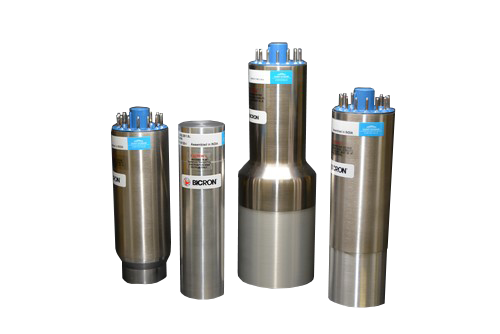Scintillation Detector Configurations
The proper detector packaging and integration of scintillation crystals is a science combining advanced design and engineering skills with proven assembly techniques and materials to produce stable, high-resolution radiation detectors.
Luxium Solutions can offer a range of scintillation materials including: NaI(Tl), LaBr3(Ce), CsI, LYSO, CLLB, LaCl3, CdWO4, CaF2, BGO, YAG(Ce), BaF2 and more. Luxium can offer a variety of standard detector designs to fulfil most radiation counting applications, including:
Customisable Options
Each of the above standard detector configurations can be designed with:
Integrated assemblies for spectroscopy and radioisotope assays
In this configuration, an integrally mounted light sensing device, such as a photomultiplier tube (PMT) and silicon photomultiplier (SiPM), is optically coupled directly to the scintillator. The scintillator and light sensor are assembled in a light-tight, compact and hermetic package for optimal performance.
This design usually yields better and more consistent energy resolution than others. Therefore, these are detectors of choice for spectroscopy and radioisotope assay.
Typical Design Examples
| Scintillator | Model | Scintillator Size | PMT dia. pins | Stages | PHR @ Cs-137 |
| NaI(Tl) | 2M2/2 | 2" dia. x 2" thick | 2" 14 -pin | 8 | < 8.0% |
| NaI(Tl) | 3M3/3 | 3" dia. x 3" thick | 3" 14-pin | 10 | ≤ 7.5% |
| NaI(Tl) | 3M3/3 | 3" dia. x 3" thick | 3" 14-pin | 8 | ≤ 7.5% |
| LaBr3(Ce) | 25S25/1.5 | 1" dia. x 1" thick | 1.5" 12-pin | 8 | ≤ 3.5% |
| LaBr3(Ce) | 51S51/2 | 2" dia. x 2" thick | 2" 14-pin | 8 | ≤ 3.5% |
| LaBr3(Ce) | 51S51/3 | 2" dia. x 2" thick | 3" 14-pin | 8 | ≤ 3.0% |
Demountable assemblies
The demountable designs are made with hermetic seals to optical windows that allow the removal of the light sensor(s) without disturbing the scintillator hermetic package. This configuration is well-suited for applications requiring the use of a crystal larger than 4” diameter or multiple light sensors.
Typical Design Examples
| Scintillator | Model | Scintillator Size | PMT dia. pins | Stages | PHR @ Cs-137 |
| NaI(Tl) | 5H5/5 | 5" dia. x 5" thick | 5" 14-pin | 10 | ≤ 8.5% |
| NaI(Tl) | 6H6/5 | 6" dia. x 6" thick | 5" 14-pin | 10 | ≤ 8.5% |
| NaI(Tl) | 4X4H16/3.5A | 4" x 4" x 16" long | 3.5" 14-pin | 10 | ≤ 8.0% |
Rectangular assemblies
Scintillation detectors with square or rectangular cross-sections are a cost-effective alternative to the standard right circular cylinder. Various lengths are available, depending on the scintillator choice, with 16” being a common size. Excellent uniformity can be achieved for long square or rectangular detectors. Up to 1m lengths have been designed and assembled. The stopping power is sufficient for high-energy gammas. Common applications include aerial survey, whole-body scanning, pulse gamma neutron activation analysis (PGNAA) and portal monitors.
The most common sizes are 2"x4"x16", 3"x5"x16" and 4"x4"x16" assemblies. PMT sizes include 2", 3" and 3.5". Aluminium or stainless steel housings are common.
Applications include aerial survey, whole body counting, security portal monitoring and medium and high energy physics.
Typical Design Examples
| Scintillator | Model | Scintillator Size | PMT dia. pins | Stages | PHR @ Cs-137 |
| NaI(Tl) | 2X4H16/3A | 2" x 4" x 16" long | 3" 14-pin | 8 | ≤ 8.0% |
| NaI(Tl) | 3X5H16/3SS | 3" x 5" x 16" long | 3" 14-pin | 10 | ≤ 9.0% |
| NaI(Tl) | 4X4HG16/3.5SS | 4" x 4" x 16" long | 3.5" 14-pin | 10 | ≤ 8.5% |
Packaged assemblies
The scintillation crystal is hermetically packaged with a metal container, an optical window incorporated on one end, and reflector material between the scintillator and the container walls. A wide variety of shapes (including rectangular) and sizes can be produced. These detectors require user-supplied, externally-coupled light sensors.
Typical Design Examples
| Model | Scintillator Size | PHR @ Cs-137 |
| 2R2 | 2" dia. x 2" thick | ≤ 8.0% |
| 3R3 | 3" dia. x 3" thick | ≤ 8.5% |
Thin Window
Our X-ray detectors and probes are used in various low-energy and X-ray detection applications. These detectors come in three types of assemblies:
- Packaged X-ray crystals used in X-ray diffraction, X-ray fluorescence, Mossbauer studies and gauging.
- Integral X-ray detectors are used in health physics applications
- X-ray probe with fixed collimator is ideal when a constant area of exposure is needed.
All use a thin 1mm or 2mm NaI(Tl) crystal — usually 25mm (1"), 38mm (1.5") or 51mm (2") in diameter — and a radiation entrance window selected to provide the appropriate transmission for the energy of interest. The typical energy range for an assembly with a beryllium entrance window is 3 to 100 keV and 10 to 200 keV for an assembly with an aluminium entrance window.
Typical Design Examples
| Scintillator | Model | Scintillator Size | PMT dia. pins | Note | PHR @ Fe-55 |
| NaI(Tl) | 1XR .040 B | 1" dia. x 0.040" | None | Packaged | ≤ 55% |
| NaI(Tl) | 1XM .040/1.5B | 1" dia. x 0.040" | 1.5" 12-pin | Integral | ≤ 50% |
| NaI(Tl) | 1XMP .040 B | 1" dia. x 0.040" | 1" integrated | Probe with voltage divider preamp | ≤ 55% |
Documents
-
142266 Luxium Lanthanum-Material-Data-Sheet FIN
Download (648.02 kB) -
142266 Luxium Sodium-Iodide-Material-Data-Sheet FIN
Download (241.57 kB) -
Efficiency-Calculations-Brochure
Download (1.36 MB)

